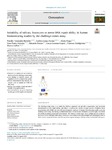Mostrar o rexistro simple do ítem
Suitability of Salivary Leucocytes to Assess DNA Repair Ability in Human Biomonitoring Studies by the Challenge-Comet Assay
| dc.contributor.author | Fernández-Bertólez, Natalia | |
| dc.contributor.author | Lema Arranz, Carlota | |
| dc.contributor.author | Fraga, S. | |
| dc.contributor.author | Teixeira, Joao | |
| dc.contributor.author | Pasaro, Eduardo | |
| dc.contributor.author | Lorenzo-López, Laura | |
| dc.contributor.author | Valdiglesias, Vanessa | |
| dc.contributor.author | Laffon, Blanca | |
| dc.date.accessioned | 2022-10-21T19:17:06Z | |
| dc.date.available | 2022-10-21T19:17:06Z | |
| dc.date.issued | 2022 | |
| dc.identifier.citation | Natalia Fernández-Bertólez, Carlota Lema-Arranz, Sónia Fraga, João Paulo Teixeira, Eduardo Pásaro, Laura Lorenzo-López, Vanessa Valdiglesias, Blanca Laffon (2022). Suitability of salivary leucocytes to assess DNA repair ability in human biomonitoring studies by the challenge-comet assay. Chemosphere, Volume 307, Part 4, 136139. ISSN 0045-6535. https://doi.org/10.1016/j.chemosphere.2022.136139. (https://www.sciencedirect.com/science/article/pii/S0045653522026327) | es_ES |
| dc.identifier.issn | 0045-6535 | |
| dc.identifier.uri | http://hdl.handle.net/2183/31866 | |
| dc.description | Financiado para publicación en acceso aberto: Universidade da Coruña/CISUG | es_ES |
| dc.description.abstract | [Abstract] The challenge-comet assay is a simple but effective approach that provides a quantitative and functional determination of DNA repair ability, and allows to monitor the kinetics of repair process. Peripheral blood mononuclear cells (PBMC) are the cells most frequently employed in human biomonitoring studies using the challenge-comet assay, but having a validated alternative of non-invasive biomatrix would be highly convenient for certain population groups and circumstances. The objective of this study was to validate the use of salivary leucocytes in the challenge-comet assay. Leucocytes were isolated from saliva samples and challenged (either in fresh or after cryopreservation) with three genotoxic agents acting by different action mechanisms: bleomycin, methyl methanesulfonate, and ultraviolet radiation. Comet assay was performed just after treatment and at other three additional time points, in order to study repair kinetics. The results obtained demonstrated that saliva leucocytes were as suitable as PBMC for assessing DNA damage of different nature that was efficiently repaired over the evaluated time points, even after 5 months of cryopreservation (after a 24 h stimulation with PHA). Furthermore, a new parameter to determine the efficacy of the repair process, independent of the initial amount of damage induced, is proposed, and recommendations to perform the challenge-comet assay with salivary leucocytes depending on the type of DNA repair to be assessed are suggested. Validation studies are needed to verify whether the method is reproducible and results reliable and comparable among laboratories and studies. | es_ES |
| dc.description.sponsorship | This work was funded by the Spanish Ministry of Science and Innovation: MCIN/AEI/10.13039/501100011033 (Grants PID2020-113788RB-I00 and PID2020-114908 GA-I00), NanoBioBarriers project (PTDC/MED-TOX/31162/2017), Xunta de Galicia (ED431B 2022/16), co-financed by the Operational Program for Competitiveness and Internationalization (POCI) through European Regional Development Funds (FEDER/FNR), Spanish Ministry of Education, Culture and Sport [BEAGAL18/00142 to V.V.], and Spanish Ministry of Economy and Competitiveness, co-financed by the European Social Fund [RYC-2015-18394 to L.L,-L,]. Funding for open access charge: Universidade da Coruña/CISUG | es_ES |
| dc.description.sponsorship | Xunta de Galicia; ED431B 2022/16 | es_ES |
| dc.description.sponsorship | Portugal. Fundação para a Ciência e a Tecnologia; PTDC/MED-TOX/31162/2017 | |
| dc.language.iso | eng | es_ES |
| dc.publisher | Elsevier | es_ES |
| dc.relation | info:eu-repo/grantAgreement/AEI/Plan Estatal de Investigación Científica y Técnica y de Innovación 2017-2020/PID2020-113788RB-I00/ES/IDENTIFICACION DE FACTORES DE RIESGO Y BIOMARCADORES DE VULNERABILIDAD AL DETERIORO COGNITIVO Y FISICO EN EL ENVEJECIMIENTO/ | |
| dc.relation | info:eu-repo/grantAgreement/AEI/Plan Estatal de Investigación Científica y Técnica y de Innovación 2017-2020/PID2020-114908GA-I00/ES/EVALUACION DEL RIESGO ASOCIADO A LA EXPOSICION A NANOMATERIALES: ESTRATEGIAS TOXICOLOGICAS IN VITRO, IN VIVO E IN SILICO/ | |
| dc.relation | info:eu-repo/grantAgreement/MICINN/Plan Estatal de Investigación Científica y Técnica y de Innovación 2017-2020/BEAGAL18%2F00142/ES/ | |
| dc.relation | info:eu-repo/grantAgreement/MINECO/Plan Estatal de Investigación Científica y Técnica y de Innovación 2013-2016/RYC-2015-18394/ES/ | |
| dc.relation.uri | https://doi.org/10.1016/j.chemosphere.2022.136139 | es_ES |
| dc.rights | Atribución-NoComercial-SinDerivadas 4.0 Internacional (CC BY-NC-ND 4.0) | es_ES |
| dc.rights.uri | https://creativecommons.org/licenses/by-nc-nd/4.0/ | * |
| dc.subject | Challenge-Comet assay | es_ES |
| dc.subject | DNA damage Response | es_ES |
| dc.subject | Frozen samples | es_ES |
| dc.subject | Human biomonitoring | es_ES |
| dc.subject | Salivary leucocytes | es_ES |
| dc.title | Suitability of Salivary Leucocytes to Assess DNA Repair Ability in Human Biomonitoring Studies by the Challenge-Comet Assay | es_ES |
| dc.type | info:eu-repo/semantics/article | es_ES |
| dc.rights.access | info:eu-repo/semantics/openAccess | es_ES |
| UDC.journalTitle | Chemosphere | es_ES |
| UDC.volume | 307 | es_ES |
| UDC.issue | 4 | es_ES |
| UDC.startPage | 136139 | es_ES |
| dc.identifier.doi | 10.1016/j.chemosphere.2022.136139 |
Ficheiros no ítem
Este ítem aparece na(s) seguinte(s) colección(s)
-
GI - NANOTOXGEN - Artigos [28]
-
GI-DICOMOSA - Artigos [38]
-
GI-GIGG - Artigos [111]






